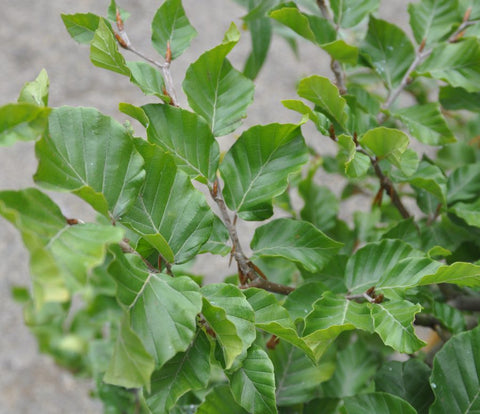Beech Tree Facts and Information
Beech Tree Facts and Information
- Latin Name: Fagus sylvatica
- Native words: Old Irish () Scots Gaelic () Old English () Welsh () eastern Celtic ()
- Ogham sign:
- Height when mature: 30-40m (98-130ft)
- Height after 10 years: 3m

Beech Tree Botanical Description:
In late winter, Beech Trees are clearly identifiable by their alternate slender bronze buds ready to develop on zigzagging twigs. The emergence of the stunning green foliage of beech in April is one of the most attractive sights in a springtime wood. The leaves are approximately 9 cm long with short wavy margins and five to seven pairs of parallel veins.
The bark is smooth and grey and mature beech trees have a light wispy look to their outer twigs, while the main side branches can often be as thick as many other tree species trunks’.
In autumn beech develops bristly seed pods which fall and open to reveal nut like seeds known as ‘mast’. Beech nuts are distinctively 3-sided and the opened pods often remain on the tree long after the seed has fallen.
The crackly, bronze dead leaves often remain right through winter, especially on young trees, which are not prey to high winds. When they do fall, the leaves often carpet the wood floor to such an extent that little else can grow; woods often become exclusively beech over time. Examples of this include the famous Burnham Beeches near Windsor. Beech trees can develop into giants which tower over all other woodland trees and can live to 300 years.
Natural History and Ancient Wisdom of Beech Trees:
Historically, Beech Trees grows native in England south of a line from the Wash to the Severn; elsewhere it was always originally planted, although it now grows wild throughout. Although beech trees grow well on chalk, windbreaks of mature beech can be seen growing high in the Derbyshire Peak District and in lowland river valleys.
Many of what now seems like ancient beech woods were actually planted by man quite recently. The great beech forests of the Chilterns are almost entirely planted in the 18th century. It became fashionable for Beech trees to be planted in the grounds of private estates of wealthy landowners in the 17/18th centuries because of their stately aspect.
In the great storm of 1987 which hit southern England, beech trees took the brunt and thousands of mature trees were felled. In their place, other species, often fast-growing trees like sycamore and ash have taken over beech woods, as a lack of management has prevented a restocking of beech.
The English word ‘book’ is derived from the Anglo Saxon ‘boec’ as writing was originally carved on beech wood, as it is soft. This tradition is carried on; if ash is the “lightning tree”, beech is surely the “graffiti tree”, as the bark of many beech trees is covered in personal names and dates going back centuries. It may have been that early writing was actually carved on the soft bark and not the hardwood. Beech is one of the best woods for woodwork; even now many kitchen units and cabinets are beech veneer.

Beech Place Names:
- Bockhampton (Berkshire) - ‘settlement where beeches grew’
- Buckholt (Hampshire) - beech wood’
- Buckhurst (Essex) - ‘beech wood’
Beech Trees Wildlife Rating:
Good.
Beech mast is a favourite food of many woodland animals such as badgers, deer, mice and squirrels and birds.
Rare plants such as the Birds Nest Orchid grow in the leaf litter.
The leaves are eaten by caterpillars, including those of the lobster moth and least black arches.
Beech Trees Good Points / Bad Points:
- Excellent for hedging.
- The variety Copper Beech (Fagus sylvatica pupurea), has glossy burgundy, purple leaves, is a beautiful standard tree for larger gardens and parks.
- Avenues of mature beeches are very striking alongside long driveways to substantial residences.
- Perfect for large gardens.
Beech Trees Bad Points:
- As beech is shallow rooted, mature trees are at risk of being uprooted in high winds. This may affect the siting of trees near houses.
- If you intend to grow it as a standard tree, Beech is only suitable for large gardens.
- Not suitable for small gardens.
Want to buy a Beech tree?
Tree2mydoor is a specialist tree gifts company. We have been happily supplying many different trees and plants as gifts for over 15 years.
Our Beech Tree Gift is perfect for sending to friends and family members. This sapling comes with a long history and has lots of meaning behind it making it a popular tree to plant in memory of lost loved ones and relatives.
If you are looking for something a little more established we have some larger trees in the form of our Large Copper Beech Tree Gift and Common Beech Tree, both are supplied in 12L pots and measure approx 1.5m in height.
A native tree that's a little different to the rest is our Copper Beech Tree Gift is ideal. Also known as Purple Beech its foliage is a very deep burgundy in colour which then transforms into a blaze of orange for the autumn.
We also offer corporate promotional services with our products so if you have some ideas for green company gift incentives then get in touch at care@tree2mydoor.com and we will bring your eco-friendly gift ideas to life.